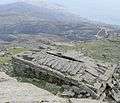Dragon houses
The dragon houses (Greek: Δρακόσπιτα, Drakospita) or Draga (Δραγκά) are some 20 large, ruined buildings found in the south of the island of Euboea, Greece. They were built with massive stone blocks without mortar and large stone slabs for the roofs. The Dragon House on Mount Ochi (Δρακόσπιτο της Όχης), north of Karystos is the most famous and well preserved. Other notable buildings are located in Palli-Lakka (Πάλλη-Λάκκα Δραγκά) and in Kapsala. In local folklore "dragons" are not only reptilian monsters but also beings with superhuman powers.
There is no accepted theory about the identity of the builders nor an agreed estimation on their dating. No mention is identified in classical texts and the first account is from the 18th-century British geologist, traveler and writer John Hawkins[1]
The French classical scholar Jules Girard visited Euboea and described the Ochi dragon house, and provided further descriptions of the three Palli-Lakka Dragon houses[2]
The Swiss archaeologist Karl Reber has tracked down all reported buildings and published a report in 2010.[3]
Gallery
-

on Ochi (north)
-

on Ochi (south)
-
on Ochi (inside)
-
Palli-Lakka (east)
-

Palli-Lakka (north)
-

Kapsala
References
- ↑ Hawkins J., An Account of the Discovery of a very Ancient Temple on Mount Ocha in Euboea , In: R. Walpole: Travels in Various Countries of the East London 1820, pp 285-293 (online)
- ↑ Girard J., Mémoire sur l'île d'Eubée In: Archives des missions scientifiques et littéraires, Paris, 1851, Vol. 2, pp. 708-714, and picture (online)
- ↑ Reber K., The Dragon Houses of Styra: Topography, Architecture. and Function , Mediterranean Archaeology and Archaeometry, Vol. 10, 2010, No. 3, pp 53 -61 ((pdf))